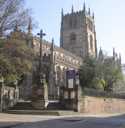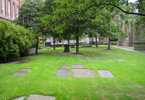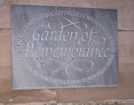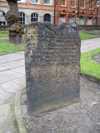 Nottingham Nottingham
St Mary
Churchyard
The churchyard contains an area of approximately 6270 square yards including
the site of the church: the boundaries are, on the North: Kayes Walk, the South:
High Pavement, the East: Stoney Street, the West: St Mary’s Gate.
In addition to the Churchyard
around the Church, several
other burial grounds have
been used by St Mary’s since
the 18th Century.
St Mary’s churchyard has served at least three churches suggesting
that people have been buried here since Anglo Saxon times.
Stone Coffins
The Stone coffin in St Mary’s churchyard was unearthed
in February 1912 when the Lady Chapel was
being built. For years it stood lidless on the grass but was moved to make
way for the Memorial Garden, dedicated at Easter 2002. Now, filled with earth,
it serves as a flower trough near the east wall of the chancel.
Stone coffins are occasionally seen in ancient churchyards, sometimes with
interestingly carved covers. Although they were for high status burials they
were recovered at a later date and reused for other burials. A second stone
coffin was found in February 1912 four feet deep but badly damaged and is no
longer to be seen. In the Chapter House there is a framed drawing of this coffin
which had contained a small silver cross. Alfred
Stapleton mentions graves in the same area cut into the bedrock of the
churchyard six or seven feet below the level of the church which bore the same
distinctive hole cut for the head as can be seen in the stone coffins.
In 1948 a Faculty for laying down the headstones included ‘to remove
the ancient stone coffins at present outside the church...’
Bone Holes
In the past churchyard space was re-used and bones from previous graves stored
in ossuaries, bone holes or bone houses. Bone holes excavated from the sandstone
in the churchyard provided storage when old graves were excavated for new ones.
The medieval door on the north wall was once an exterior door into the church.
It has been confirmed by English Heritage that the area behind it was once
a chantry chapel which was built after the church
was completed. It was being used as a bone house in the first quarter of the
19th century when a note was made that the heating
furnace was situated under it.
A Mr Samuel Smith claimed that between 1819 and 1826 there was a small trapdoor
in the churchyard near the wall next to St Mary’s Gate, which appeared
to be a bone hole. He mentions two slate gravestones dated 1736 and 1758 forming
a side and top to this shaft. He descended the ladder inside the shaft and
discovered a cave containing bones.
A bone hole excavated out of the rock, probably the one described by Mr Smith
and existing as late as 1912 (by the High Pavement boundary wall in line with
the south west corner of the church) was marked by a ventilation grating which
rested on three side stones. It was filled up with surplus soil excavated during
building work on the Lady Chapel in February 1912 and the site obliterated.
However, it is described by Alfred Stapleton, who visited it in January that
year. It was entered by climbing down a ladder in a narrow brick-lined shaft
with the churchyard wall forming the fourth side of the shaft. The cave hollowed
out of the bedrock was roughly circular and estimated to be up to 11½ feet
wide. Cut into the rocky sides were shelved recesses about 15 inches wide.
In 1911 the heating apparatus for the church was operated from a deep rock
excavation 40 steps down on the north side of the church between the old vestry
and the north transept and reputed to have been a bone hole. It was rediscovered
in the 1990s when a paving stone collapsed but was immediately resealed.
Earliest Descriptions
Possibly the earliest eyewitness mention of the churchyard is that of an
action to recover the value of a tombstone broken by the felling of a tree.
The year was 1394, the stone (value 6s 8d) was on the
tomb of one Robert Langar; the complainant was John Albyn, the plaintiff John
Ile and the Vicar at the time was Robert de Retford.
From 1600, victims of the county gallows were interred in the churchyard between
the Vicar’s vestry and north transept. On the 7 July 1600 it is recorded
that six named persons were “Executed and Buryed”. Other instances
of multiple executions are recorded in 1631, 1646, 1647 and 1679. Many prisoners
from the Queen’s and King’s gaol who died whilst in captivity are
also buried in the churchyard, as was Katherin, a young maid servant unto
Richard Singell who hanged herself, 12 July 1605.
On 30th July 1776 James Bromage and William
Wainer, two young men who had formerly been of good character but found guilty
of robbery were made to listen to a sermon, then lie in the graves they would
occupy later to check the fit before walking to the gallows in their shrouds.
St Mary’s Churchyard was not always the peaceful place it is now.
In ancient days churchyards were used for all sorts of purposes which we would
find very strange. Merrymaking and church ales were held within its borders.
On 12th October 1629, the Mickletorn Jury, a
body which was charged with the general oversight of the decorum and well-being
of the medieval town prosecuted Ann Hind for wilfully putting her swine
into the churchyard, whereof she deserves great punishment.
Thoroton’s 1670 map shows a row of houses along the High Pavement frontage
of the churchyard, commencing at St Mary’s Gate – with an
additional house at the corner of High Pavement and Stoney Street. Blackner
describes them as a ‘chantry house belonging to the Bridge Estate and
several little dwellings belonging to the vicarage’.
A vestry meeting in July 1719 records that the churchwardens of St Mary’s
should allow the Vicar £2, at two payments, in consideration of a house
in the churchyard ‘at the north-west end of the Church, near Dr Bee’s
house’, which the contemporary Vicar, Samuel Berdmore, consented should
be pulled down. The Borough records say:
It is this day ordered yat the chamberlyns for the tyme
being take downe the several howses against the south side of Saint Marye’s
churchyard that are now untenanted thereof to the use of this Corporation.
Hollow Stone was widened in 1740 and the house on the corner of Stoney Street
which had belonged to the Duke of Kingston no longer existed when the 1744
Badder & Peet map was made. The Terrier mentions a house in the churchyard
having been taken down to enlarge the space for burials.
Churchyard Wall
In 1792 the other houses were demolished and
the old churchyard wall and a portion of the churchyard cut away. There are
stories of graves being disturbed during the work.
At the end of the 18th century the churchyard
extended across Kayes Walk to large houses and gardens in a continuous sweep
of green. The wealthy Plumptre family had only yards to walk across the churchyard
from their house to take their places in the North transept, reserved for their
use.
The present east wall along Stoney Street was built
in 1804, followed by the south wall along High Pavement. In 1806 the churchyard
was enclosed by iron railings with a gate at each corner. At the entrance to
the churchyard were iron rings that held thick glass globes of whale oil with
a floating wick for lighting before gas lighting was introduced to Nottingham.
Two of these were recorded in 1928 and one is still to be seen at the High
Pavement entrance at the top of Hollow Stone.
Kayes Walk was constructed
in 1807 and taken off the north side, which had formerly been
part of the churchyard. Prior to that there was a public footpath through the
churchyard linking St Mary’s Gate with Stoney Street. There was
a stile at each end of the path, the one at the east end commonly accepted
to have been over 200 years old. Eight old gravestones were propped up against
the church wall, the remains of some can now be seen along this busy pathway.
The fact that it had originally been part of the churchyard explains why human
remains were discovered beneath it when the pavement on Kayes Walk collapsed
during work on the footpath in 1998.
Kayes Walk was named after the Rev Sir Richard Kaye, Bart LL.D., Rector of Marylebone,
Prebend of Southwell,
Archdeacon of Nottingham and Prebend and Dean of Lincoln.
He died in 1809 and was buried at Lincoln but had something more remarkable
than a pathway named after him. Captain Cook’s Journal dated 11th May
1778 tells:
I bore up for the island – I left a bottle with a
paper in it on which were inscribed the names of the ships and the date of
our discovery, and along with it I enclosed two silver twopenny pieces of his
Majesty’s coin of the date 1772. These, with many others, were furnished
me by Rev. Dr. Kaye (now Dean of Lincoln) and as a mark of my esteem and regard
for that gentleman; I named the island after him, ‘Kaye’s Island’.
At the corner of Kayes Walk and St Mary’s Gate stood a large house
where in 1812, Mr Trentham, the owner, was shot at his front door by miscreants
who had been hiding behind the tombstones in the churchyard. He survived but
his attackers were never caught, despite large rewards being offered. After
Mr Trentham’s death in 1820 the house was owned by Mr Daft
Smith Churchill, one of the original directors of the General Cemetery. Mr Churchill
perished in the wreck of the ‘Forfarshire’ off Farne Lighthouse
in 1837. The tragedy is best known for the story of the courage of Grace Darling
and her father who rowed out in an attempt to rescue the victims of the wreck.
A large monument was erected by his co-directors in memory of Mr Churchill
near the Derby Road entrance of the General Cemetery. However after his death
his son had it demolished. During excavations for the cellars and foundations
a long tunnel was discovered running northwards from the graveyard. A wall
was built across it for the foundations of the new building.
In 1911 a Faculty was granted for the erection of a ‘Morning
Chapel’ (now known as the Lady Chapel)
on the South side of the existing Chancel
... to remove certain monuments, monumental tablets or
tombstones relating to deceased persons interred in the Churchyard of the said
Parish as specified in plan numbered three so deposited and also any bodies
or remains which may be found there under and to re-enter (sic) such
bodies or remains and place such monuments, monumental tablets or tombstones
in another portion of the said churchyard provided that a plan with the corresponding
numbers showing the positions to which such bodies or remains and also the
monuments ... tombstones are respectively removed shall be filed in the Registry
of our said Court as aforesaid.
In 1939 the Choir vestry was built on
the north side of the church and some graves were removed. The remains were
re-interred in the Southern Cemetery at Wilford Hill and certain tablets and
Memorial stones were reinstated.
The graves and tombstones removed included eleven names: Askew, Bramley, Broderip,
Eddowe, Mather, Oakland, Osborne, Porter, Robinson, Troop, Widerton.
 North
side of the North
side of the
churchyard with many
stones laid flat |
In 1948 a Faculty was granted to lay down the gravestones
in the churchyard. Exceptions included the terra cotta Sefton memorial and
the table tomb to the memory of William Crofts. The ancient stone coffins at
present outside the church were moved and any stones which had been part of
the church fabric were buried in the churchyard.
Alfred Stapleton mentions that both Deering and Blackner had seen ancient
tombs and memorials at St Mary’s and thought it was a pity they
hadn’t recorded them for posterity. Old stories about obsolete gravestones
being recycled include one in premises in St Mary’s Gate and another
one in a cellar on Kayes Walk.
Named Tombstones
In 1907 Alfred Stapleton transcribed the memorials in the
St. Mary’s Churchyard and Burying grounds. Stapleton recorded a total
of about 600 stones, 580 memorials, some illegible, making approximately 550
supplying definite information, one third of which carry visible 18th century
dates, one quarter carrying 19th century in addition
to 18th century dates in the churchyard. The
earliest is 1707 and the latest is 1882, alphabetically Abnet to Young; 440
surnames, with additional 22 unduplicated surnames which were used as Christian
names. The Barker Gate memorials range alphabetically from Aldridge to Young
and total 210 with 13 surnames used as Christian names.
The War Memorial at the south west gate was dedicated
in 1922.
 Plaque
on the east Plaque
on the east
end of the church |
Garden of Remembrance
In 1958 permission was granted to reserve a space at the east end of the church
for the interment of cremated remains. This area is now a Garden of Remembrance.
The plaque on the outside of the west wall indicating the Garden of Remembrance
was made by stone mason John Shaw MA FRSA of Saxby, Lincolnshire. It was dedicated
on Easter Sunday 2002
Interesting Graves in the Churchyard
Buried in St. Mary’s old graveyards are people from Crich (Derbyshire),
Leeds, several from Leicestershire, Belton near Grantham, Woolsthorpe by Belvoir
Castle and Manchester. One interesting memorial was to a Mr Taylor who
died on his passage from Tahiti to Melbourne.
 Clay headstone of Clay headstone of
the Sefton family |
The oldest stone is one engraved “Morris 1713” lying in the paving
to the west of the church. The latest was that of Alderman Twiner dated 1882.
One of the earliest, rarest and most unusual memorials in the churchyard today
is the clay gravestone made by clay-pipe-maker William Sefton for his two youngest
daughters, Elizabeth and Mary who died in 1707 (the earliest date in the churchyard)
and 1714 respectively. After nearly 300 years, this stone is now rather weathered
but some of the letters stamped onto it can still be seen. The stone remains
upright near the path at the northwest corner of the church.
In 1907 Alfred Stapleton recorded the words with the comment, “The inscription
now difficult to read”:
| Here lyeth the body of Mary the daughter of Wm. & Elizabeth Sefton
who departed this life May the 30th in
the 6th year of her age in 17[1]4. Here
lyeth the body of Elezabeth ye daughter of Wm. & Elezabeth Sefton
who departed this life May the 29 in the **th year of her age in 1707. |
Bearing in mind how it was made, this stone must have been made after the
death of the second daughter.
On the north (Kayes Walk) side of the churchyard is the grave of William Doubleday
Crofts, chief ringer and conductor of St Mary’s bell
ringers in the 1770s.
On the north side of the churchyard are the graves of George
Africanus and his wife Esther and that of George Africanus junior their 14
year-old son. Nottingham’s first black citizen, George Africanus came
as a child from Sierra Leone, was brought up by Benjamin Molyneux in Wolverhampton,
baptised, educated, trained as a brassfounder, married into a Nottingham family,
became a burgess with full voting rights, prospered, bought his house and lived
in Nottingham from about 1784 until his death at the age of about 71 in 1834.
The gravestone of George and his wife Esther was probably erected by their
only surviving daughter Hannah and read:
In memory of George Africanus who died May 19th 1834
aged 70 years Also Ester Africanus, wife of the above Who died May
12th 1853 Aged 81 years
O cruel death that separated here
A loving father from his daughter dear
Also a tender parent in decline of life
A loving mother and a careful wife
While in this world they did remain
Their latter Days were full of pain. |
The sandstone gravestone of George senior was heavily weathered and became
impossible to read. A new slate memorial with the freshly engraved inscription
was inserted into it for the Bicentenary of the 1807 abolition of slavery.
From The Parish Records: (1763-1796) Burials: Isaac Son of Thomas Beardsley.
An extraordinary story is related on the headstone, in St Mary’s
churchyard, to the memory of this unfortunate youth:
In memory of Isaac Beardsley the son of Thomas & Eliz: Beardsley
who Departed this life the 9th day of
November 1765: in ye 12th Year of his
Age.
Stop Passenger to Ponder on this stone,
And think how soon this cruel Deed was done;
A wicked Wretch Pursu’d my Life to Slay,
Because to shut a Gate I would not stay:
So he pursu’d till me he over took,
Just by a Gap on th’ Margin of a Brook
And fear’d it is he firmly did intend
To my short Life to put a final end |
This headstone was recorded in 1907 by Alfred Stapleton but is no longer to
be found.
Click here for information about
St Mary’s other Burial Grounds
| 


 North
side of the
North
side of the Plaque
on the east
Plaque
on the east Clay headstone of
Clay headstone of







